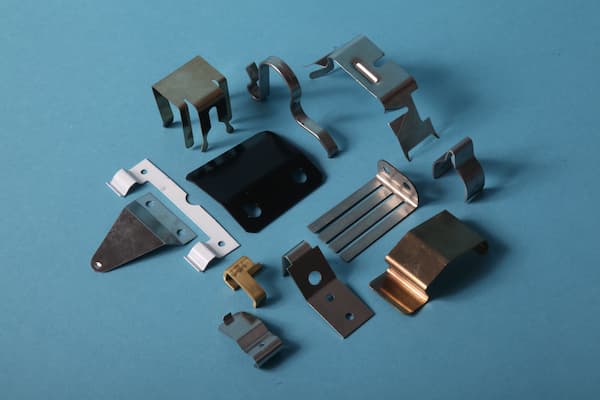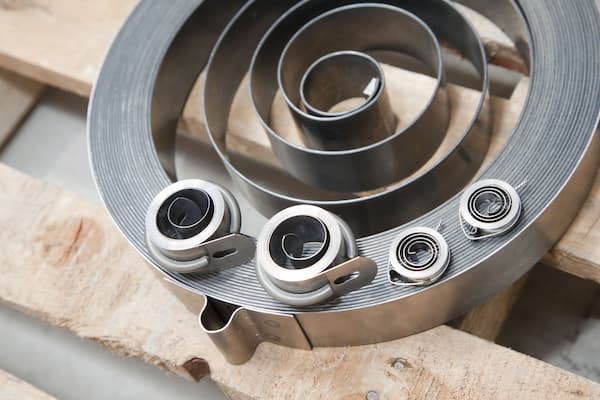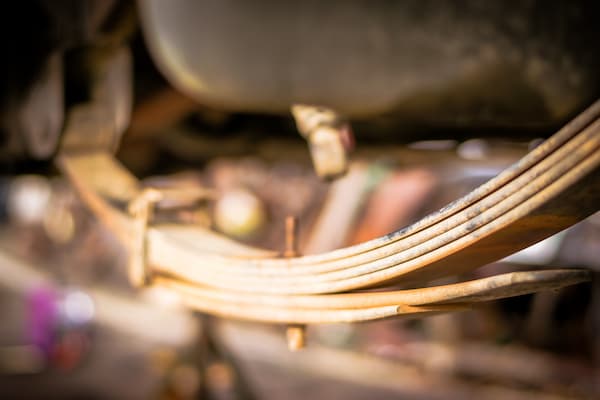When most people think of springs, they usually picture the classic helical shape – a tightly wound coil of wire typically found in compression and tension springs. While coiled springs are incredibly popular and functional, sometimes a more unusual, bespoke spring is required for a specific application. Today, we will take a closer look at flat springs, how they work and where they’re used.

What Are Flat Springs?
Flat springs are flat strips of material (usually metal) that store and release energy when deflected by an external load. Unlike helical springs, which are typically made from coiled wire, flat springs are cut or pressed from sheet metal. They come in various shapes and sizes, usually produced by flat spring manufacturers to suit specific applications; many are small, stamped pieces of metal that control deflection in restricted spaces. They are favoured in applications in which space is limited or when the spring is part of a more extensive mounting assembly.
If you look at the shape of some flat springs, it can be hard to comprehend how they can be classified as springs. Many of these springs simply look like metal pressings and don’t appear to offer much flexibility – a requirement for storing and releasing energy effectively. But, providing the spring has been made from high-grade material and manufactured to precision, flat springs can store and release energy as effectively as their helical counterparts under the right conditions.
Applications for Flat Springs
Custom spring manufacturers can create flat springs in a massive range of different forms, with the potential for entirely bespoke shapes and pressings, suitable for numerous applications across a wide variety of industries. Some examples of flat springs and their uses include:
- Electrical contacts – a flat, flexible piece of metal that completes an electrical circuit when pressed
- Cantilever springs – flat springs supported at one end and holding a load at or near the other end
- Leaf Springs – predominantly used in automobile suspension
- Belleville washers – also know as a coned-disc spring, conical spring washer or disc spring. They allow flexibility to a bolted joint or bearing
- Spring clips – for everything from holding pictures inside picture frames to shelf edge clips to U Clips

Popular Flat Springs
The name flat springs span a massive range of spring shapes and sizes, and whilst many are tiny pieces of flexible metal used in intricate assemblies, some are much bigger and slightly more complex.
Constant-Force Springs
These springs are flat strips of material (often metal) that coil around themselves or a drum at a near-perfectly constant radius. As the spring is deflected, the pre-existing stress of the spring material resists the loading force. This is similar to how classic extension springs function, except that constant-force springs, have a near-constant torque, hence the name. The constant torque is achieved when the outer end of the spring is attached to another spool and wound either in reverse or in the same direction as it was initially wound, maintaining a near-constant force regardless of extension length.
Constant force springs are used in applications where a constant load is required, including:
- Cable retractors
- Door closers
- Counterbalancers
- Gym equipment
- Electrical motors
Leaf Springs
Leaf springs are one of the oldest springs, dating back to the mid 17th century where they were used on horse-drawn carriages and are still used today, predominantly in vehicle suspension. Leaf springs are made of one or more flat metal leaves typically manufactured from high-alloy steel. They can be broken down into subcategories:
- Mono-Leaf Spring – a single arc of steel that is thicker in the centre and thinner at the ends
- Multi-Leaf Spring – several arcs of steel strips of varying sizes that are stacked on top of one another with the shortest strips at the bottom and the longest at the top

What Materials Are Flat Springs Made From?
Flat springs can be manufactured from various metals and alloys, although the process is much different to creating helical springs as flat springs are pressed or cut from sheet metal rather than formed from wire. Your chosen material will depend on the end application, but it is possible to create flat springs from:
- Copper
- Bronze
- Carbon and Stainless Steels
- Brass
- Aluminium
- Beryllium
- Nickel-based alloys
Special consideration must be given when manufacturing flat springs and pressings, particularly custom designs. Many carbon and stainless steels will require treating, hardening or tempering after forming to ensure strength and corrosion resistance. Small, delicate flat springs need to be treated with care, particularly during the de-burring process, which can influence the function of the spring.
If you’re looking to purchase flat springs or pressings, always make sure to choose reputable, high-quality spring manufacturers. It’s important to work with a company that will be honest, and upfront about the costs and processes involved in creating and testing bespoke springs are fittings. Contact us today if you would like more information about how Airedale Springs can help with your customer spring requirements.

